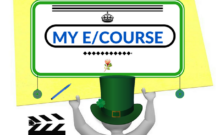HOW TO WORK OUT MY E/COURSE PLATFORM
In part three in this series of posts on the first steps in creating an online business we take a look at the three most common types of platforms that people put their e/courses up on.
If you have read the two previous posts you would have found out about bit about your industry and have worked out what type of e/course model is for you, now comes working out what platform is right for your e/course.
PLATFORMS
A platform basically refers to yours or another company website and how you’re going to present your course online. There are three main types of platforms.
- You have the big platforms such as for example Udemy or Lynda.com or Creative Live. These types 0f sites host hundreds if not thousands of different courses and come with certain requirements, such as for example your course needs to be all done in video presentation in most of the cases. If this is your type of course format where you want to do it all in video then the big platforms may be good for you. Most charge a 40 to 50% split and the price recommended to set your e/course is often low, however they are very popular, but your course is also generally alongside with all the other courses and in addition if it’s a popular topic there will be a lot of other courses competing against yours, however these type of platforms can have a big audience depending on the niche that you’re in, plus you can get exposure because of the advertising the company does as well on your behalf. Often some of the courses are for free or low priced depending on what they are and special deals can be on offer at times also if you subscribe to their newsletter.
- The next type of platforms are ones which are software created by a third party for owners of e/courses to upload their e/course and are what I like to call medium range platforms. They are ones where you put your course up on their platform and they have the software which can be basic but good enough for you to put your modules up and maintain your course. They may lack graphic design some of them and depending on the pricing plans you have to pay if you want to showcase your name course logo or add extra features. However overall there is less work in maintaining your e/course. All you do is simply upload your course once it’s created on your computer. In payment terms like the big platforms they take a percentage of each sale. There is less maintenance than if you have your own website but you are not as liberal in what you can do in how you want to create your course, and there is not the personal creative touch as much as there is when you create your own platform. If you just want to create an e/course as an extension to help in your work and put it up online and virtually forget about it or do minimum on it, then theses type of platforms may suit you.
- The last type of mainstream platform which is one where you have your own membership site and run it on a free platform such as WordPress for example. Alternatively you can purchase a software suite that enables you to create your own website such as “Dreamweaver” for example and put your course up online through that. Either way you create and maintain your e/course on your own site. WordPress is a free content management system where it’s not necessary to know any coding.
Any good e/course training program such as my training course Your Ecourse Blueprint should have all about how to set up your own membership site.
If it doesn’t then I recommend you steer clear of it as you want to select a training course that teaches everything in one package from the creation all the way through to the technical and marketing aspects of online business and e/course creation. Membership sites are the most common type of platform for this and are the best type of site to get as they protect your content and have integration with payment gateways and are secure for members. There is more maintenance however, you can outsource a lot of it once you have your site up and running and are familiar with the process and what needs doing, also you have greater control and flexibility over what you do and put up for your subscribers. The payment side of things has more flexibility also as you can create a monthly recurring payment plan if you want that or just set a one-off fee for your course Membership platforms are popular also for giving better training as they can be more group interactive and sharing of information and student supportive—and of course there is no percentage of the course cost going to a third-party like in the bigger platforms. When you have your own platform you need to consider that they are more attention focused and work better as a result of giving more value to your customer.
While the above may sound like a lot of work it really isn’t as most of the things don’t take long to do and a lot of the day to day tasks can be streamlined once your business is finally set up online. In the end ultimately less time involved in it overall and you’re giving greater value in the time you spend working on your online business-e/course.
Overall an online business means planning, building and marketing, and in future posts we will be looking at each part more closely and what it takes to get each one up and running successfully and if you’re wondering what sort of online business you might like to try then you may want to take a look at my online business training course in how to create Your E/course Blueprint to sell online especially if you’re looking for a product or niche that you can make an income from online.
______________________________________________________________________




